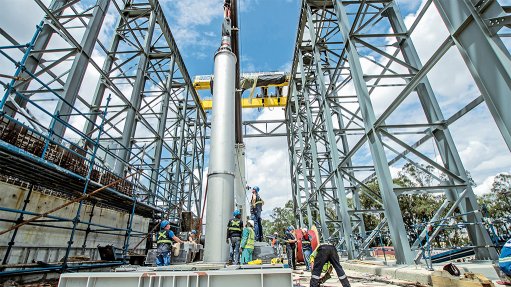
PUMP INSTALLATION Installation of an Andritz pump supplied by AQS to a mine.
Dewatering processes at gold mines can mitigate unsafe working conditions for miners, says AQS Liquid Transfer industrial sales manager Howard Jones.
The capital expenditure required for the correct and most reliable pumping equipment is minute in comparison with the costs associated with the loss of production, as well as the effect on safety and the general running of the mine.”
Failure to implement dewatering processes at gold mines can create environments that are not conducive to meeting health and safety regulations, which, in turn, can lead to a mine being closed for extended periods.
Jones adds that a substantial amount of process water is being circulated throughout mining process plant activities; should a dewatering pump fail, the circuit would come to a halt, leading to production losses amounting to millions of rands.
Further, some mines’ heads of procurement opt not to invest in costly premium dewatering equipment to increase their earnings potential by meeting key performance indicators for bonuses.
“This type of practice does not always create synergy between engineering excellence, minimum downtime and seamless production,” he says.
Correct construction materials and pump sizes play a major role in ensuring that the dewatering equipment supplied is reliable and complies with dewatering applications and mine site conditions. Failure to select adequate materials can also result in production losses and premature failure, Jones adds.
He thus explains that adequate maintenance programmes are also important as they allow for early detection of potential failures of the equipment.
“Preventive maintenance programmes are always preferable, as they result in the mitigation of catastrophic failures where the equipment must be replaced as opposed to the normal replacement of wearing components.”
To tackle the removal of seepage and drilling water from the workface, Jones explains that AQS’ air-operated, double-diaphragm pumps are manoeuvrable and mobile, as they do not require electrical connections or rely on exposed cables, consequently mitigating potential safety hazards.
These pumps supply water into underground transfer dams where booster pumps move the water into the next level, allowing for the dewatering process to take place and eventually move to the surface where the water is used for multiple purposes.
AQS has also supplied two steel-hulled pontoons to the gold mining industry. Both are equipped with an end-suction centrifugal pump directly coupled with a 110 kW electric motor. Collectively, the pumps supply a total of 1.5-million litres of water an hour over 4.2 km, “all day, every day”.
Moreover, the company’s NOV progressive cavity pumps range has proven successful, owing to its technical superiority, despite issues pertaining to the volatility of the exchange rate and longer shipping times, says Jones.
“Dewatering products supplied by AQS have proven to be the solution to many mining challenges for the past 19 years, with globally recognised brands, such as Sandpiper, Versamatic and Vega leading the way, and brands, such as NOV, Andritz, Abaque and Viking Pumps, having recently been added to the market offering. This enables us to address larger dewatering projects and other applications in the plant,” he says.
The company aims to assist mines with the design and supply of reliable products and engineered-to-order systems that will help mines achieve production targets with minimal downtime in the medium and long term.
Jones notes that AQS’ branch network is located in traditional mining areas, enabling the company to confidently service and support clients by providing advice and products.
“We are striving to support all aspects of fluid management – from dewatering, services water for drilling, dust suppression, wastewater and pressure boosting for multiple applications to chemical dosing and medium slurry applications,” he concludes.